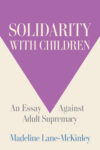
[McNally Editions; 2025]
Tr. from the Kannada by Srinath Perur
The first is a portrait, and the second is a moving image. This was what I found myself thinking after I finished Sakina’s Kiss, Vivek Shanbhag’s second book to be translated from Kannada into English by Srinath Perur. The two works are narrated by similar first-person narrators, secretive and observant men who watch their families closely and recount the changes happening to these units as if they mirror the whole world.
But Shanbhag’s first novella, Ghachar Ghochar, is tight and neat. The narrator delivers a perfectly-drawn monologue that traces how his joint family of six has become closer and less moral as their business has grown. His second, Sakina’s Kiss, is less perfect. The story continues to move long after its pages are done. The speaker Venkat soliloquizes unevenly; he will spot a mundane object and begin to reminisce. His nervous mannerisms, we understand as the story goes on, have everything to do with what he is losing.
I was impressed with Ghachar Ghochar’s precision, but found myself thinking about Sakina’s Kiss weeks after I’d finished it. What Venkat is losing is something starkly global, something out of the flat cosmopolitan. He and his wife Viji live in the Indian tech capital Bengaluru. They read self-help books, earn double incomes at interchangeable jobs, and carry along a marriage that teeters on having been arranged. “To put it simply, if you averaged out various aspects of the lives of lakhs of people like ourselves, you might as well be describing us.”
Venkat’s beliefs start to crystallize as the book progresses. Media theorist Neil Postman might put it like this: Venkat grew up in a world organized by text, into which a child could only gain entrance by becoming more literate. In his younger years, he knew that there were world secrets that only adults could know. By the time he grew up and encountered these secrets, he knew enough about shame and culture to act predictably and safely. The way of the world, he believes, is one in which certain political and personal compromises must be made in order to keep our society functioning.
Rekha, on the other hand, is growing up in the era of the image. A screen can be glimpsed and understood across generations without needing any sort of education. The image is the perfect domain for politics, with its direct appeal to feelings. One day, Venkat turns on the television, and a conservative politician appears on-screen. The man makes several comments about women avoiding provocative clothing, and Rekha becomes angry. Viji joins her; Rekha is an activist, a blogger, a firebrand who threatens to change her name to “Jennifer or Isabella,” from whom Viji has learned something about speaking out. But Venkat can not seem to turn off the television. On and on it drones, and he finds that “words that had never been heard in our household ran through it in a torrent.”
Rekha slowly undoes Venkat’s dreams of remaining average. She questions his politics without sympathy. When she disappears, Venkat’s life begins to unravel. “Idealism is a bed of thorns for people like us,” Venkat remembers his friend telling him. “It makes a peaceful life impossible.”
In 2009, Shanbhag published Sirigannada, an English-language anthology of Kannada literature. He recounts the many movements that have occurred in the language. Eventually, he writes that there are no such movements today. Large-scale changes have taken hold of the state. Thick air pollution, stand-still traffic, and increasingly hot temperatures have set into the capital city. Kannada is spoken less-and-less each day as Bengaluru receives new entrants from other parts of India and around the globe; the importance of any internal Kannada movement pales in comparison to the forces outside of the language.
“In one form or the other, Kannada literature has expressed this [fragmentation],” he writes. “The stark absence of a movement no longer threw people together, it reduced interaction among them and hence, each of the writers, blissful in their cosy islands, wrote about what they thought was the most important thing in this world. Hence, a post-modern mosaic of multiple centers and multiple beliefs was unconsciously created.”
Sakina’s Kiss is an attempt to travel between two of these islands, the village Gothic and the urban global. Half of the novel is in Bengaluru. There, the prose is plain and non-descript. It’s hard to distinguish Venkat and Viji’s lives from those in any other modern city. There are two-bedroom apartments, busy corporate work lives, and constant nudges to improve oneself. Unlike Ghachar Ghochar, in which Srinath Perur retained and italicized some Kannada words in the translation, Sakina’s Kiss reads as if it’s written, first, in English.
Until Rekha disappears, and Venkat and Viji rush to his village to find her. Suddenly, the prose contains details of resentful servants, rickety estates, and winding roads. There is an old family estate that houses a violent secret, one that Venkat knows well. They wait, nervously, for any news of their daughter. Venkat gazes at a length of rusty wire that they used to pierce through the hearts of letters to hang them up. He drifts off into a long-buried memory.
For the first time in a hundred-odd pages, we are introduced to Ramana, Venkat’s mother’s brother, a young idealist who cared about problems large and minute, from “the cups in which workers were served tea to their salaries.” We learn that Venkat’s father has stolen this land from Ramana. And that Venkat, with age, has found a way to participate in this exploitation.
Ramana, who has long-since disappeared, was often gone in Venkat’s childhood. He’d only communicate with the family in letters written in an “ancient undeciphered script.” Perur’s translations, until this point, have been casual and informal. It is only when Venkat describes the letter that we get a rare moment of description: “It wasn’t even clear what script these knotted, twisted, winding, slithering, overwritten, crooked, jagged marks on the paper represented.”
Ramana’s letters elicit reactions: He is confusing, an idealist who is always involved with the latest issue. But the letters are also as flat as images. They can not understand him any deeper. Shanbhag cleverly uses the surface-level Gothic inscription to examine how a text can be as shallow as an image before it’s understood.
It is only late into Venkat’s childhood that the family is able to decipher one of Ramana’s letters. In it, he reveals that his life is in danger. This is when Venkat’s understanding of Ramana starts to change, but it’s too late. He agrees with the reactions of those around him, to stay as far away from Ramana’s life as possible. He has learned to behave.
Postman’s conclusion is damning, a closed door. Image culture, riding in on the 90s Trojan horse of television, is eating our world whole. Soon, reading will be marginalized. Losing text culture and literacy will threaten our civilization. Childhood will disappear; what would be special about that guarded period of time if even ten-year-olds can debate on every matter of the world with no clear guidance? And what will happen with adulthood?
This is where Shanbhag’s skill shines. His authorial voice never tilts in favor of either. Every character is given free rein. This balance is what he’s best at. Even flaws seem intentional. At times, Venkat’s voice is uneven and his soliloquy lapses. There was a moment when Venkat hears an urgent, plot-changing detail on a phone call. I waited for Venkat to share his thoughts. Instead, he immediately turns to dialogue with Viji. It was a misstep. Still, to me, it only made the book seem more up-in-the-air.
The culture is between two places, a family is dispersed. They are looking for what to latch on to next. What is next for the family in our changing times? For text culture, for us? Shanbhag doesn’t say. He merely narrates the arc of the change. Like the narrative, which flickers back and forth from present to past, the answer seems to lie somewhere outside of linear time.
Meghna Rao is a writer and editor from Queens, New York.
This post may contain affiliate links.






